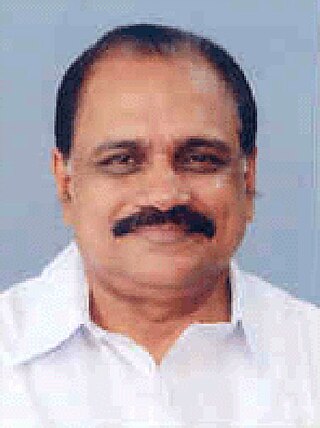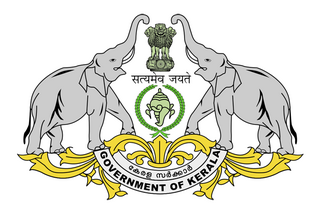
The Keralam Legislative Assembly, popularly known as the Kerala Niyamasabha, is the State Assembly of Keralam, one of the 28 states in India. The Assembly is formed by 140 elected representatives. Each elected member represents one of the 140 constituencies within the borders of Keralam and is referred to as Member of the Legislative Assembly (MLA). The present Keralam Legislative Assembly consists of 140 elected members.

The Punjab Legislative Assembly or the Punjab Vidhan Sabha is the unicameral legislature of the state of Punjab in India. The Sixteenth Punjab Legislative Assembly was constituted in March 2022. At present, it consists of 117 members, directly elected from 117 single-seat constituencies. The tenure of the Legislative Assembly is five years unless dissolved sooner. The Speaker of the sixteenth assembly is Kultar Singh Sandhwan. The meeting place of the Legislative Assembly since 6 March 1961 is the Vidhan Bhavan in Chandigarh.

The Government of Kerala, also known as the Kerala Government, is the administrative body responsible for governing Indian state of Kerala. The government is led by a chief minister, who selects all the other ministers. The chief minister and their most senior ministers belong to the supreme decision-making committee, known as the cabinet.
Palayam or Cantonment, as it is locally known, one of the busiest localities in Thiruvananthapuram, the capital of Kerala State in India. It is home to many of the administrative, cultural, and educational institutions in Kerala.
The Government of Punjab, also known as the State Government of Punjab or locally as the State Government, is the supreme governing authority of the Indian state of Punjab and its 23 districts. It consists of an executive, led by the Governor of Punjab, a judiciary and a legislative branch.

Government Law College, Thiruvananthapuram also known as GLC Trivandrum is one of the institutions imparting graduate and post graduate legal education in India. Affiliated to the University of Kerala, it is the second law college in Kerala and one of the oldest law colleges in India. It was established in 1875 by the then Maharajah of the erstwhile Princely State of Travancore. Notable alumni of the college including Judges of Supreme Court of India such as Justice Fathima Beevi, judges of High Courts, politicians, and academicians such as N. R. Madhava Menon.

The Kerala Government Secretariat is the seat of administration of the Government of Kerala, in Thiruvananthapuram, housing important ministries and bureaucratic offices. It is the highest echelon of state administrative structure offering locus for the exercise of executive authority by the State Government of Kerala. The secretariat refers to the complex of departments. Its political heads are the ministers while the administrative heads are the Secretaries to the Government. The Government Secretariat is a popular landmark and located in heart of the Thiruvananthapuram City, in Narmada Road. The Secretariat complex was originally constructed as Durbar Hall for Travancore Kingdom.

Vakkom B. Purushothaman was an Indian politician who served as the Governor of Mizoram from 2011 to 2014, Speaker of the Kerala Legislative Assembly, state minister and Lieutenant Governor of the Andaman and Nicobar Islands.
Malayil Ithappiri Markose was a politician and social activist from Kerala.

Ponnattu Chacko Joseph is a member of Janadhipathya Kerala Congress, one of the main factions of the Kerala Congress, a party born in Central Travancore or Central South Kerala region focusing on the interest of Kerala farmers. He was a member of the Kerala Legislature, representing the Muvattupuzha constituency of Kerala.

Kollam Assembly Constituency is a legislative assembly constituency in the South Indian state of Kerala. It is one among the 11 assembly constituencies in Kollam district. As of the 2021 assembly elections, the current MLA is Mukesh of CPI(M).

Chathannoor Assembly Constituency or Chathannur Assembly Constituency is a legislative assembly constituency in Kollam district of Kerala, India. As of the 2016 assembly elections, the current MLA is G. S. Jayalal of CPI.

Padmanabhan Ravindran or P. Ravindran was an Indian politician who was the Minister for Industries, Labour and Forests in Kerala from 1 November 1969 to 3 August 1970. He was the secretary of the CPI Legislature Party from 1967 to 69. Ravindran was imprisoned many times for political reasons. He also chaired as the Chairman and Managing Director of Janayugom Newspaper, Prabhatham Printers and Publishing Company. He has played a major role in building the party cadre in the state of Kerala and received the Sadanandan Award for the Best Co-operator.

Chavara state assembly constituency is a legislative assembly constituency in Kollam district of Kerala, India. It is one among the 11 assembly constituencies in Kollam district.

Kunnathur is the only Scheduled Caste reserved legislative assembly constituency in Kollam district of Kerala, India. It is one among the 11 assembly constituencies in the district. As of the 2021 assembly elections, the current MLA is Kovoor Kunjumon of RSP(L).
Alexander Parambithara was the speaker of Kerala Legislative Assembly from 13 December 1961 to 10 September 1964.
A. Nafeesath Beevi (1924-2015) was the Deputy Speaker of Kerala Legislative Assembly from 15 March 1960 to 10 September 1964.

The current Legislative Assembly is the 15th Assembly since the formation of Kerala. It was elected in the 2021 Kerala Legislative Assembly election. The Speaker is MA. N. Shamseer of CPI(M). The Deputy Speaker is Chittayam Gopakumar of CPI. The leader of the Assembly is Pinarayi Vijayan from CPI(M).The leader of opposition is V. D Satheesan. The Government Chief Whip is Dr. N Jayaraj of KCM.

The Kerala Legislative Assembly, popularly known as the Niyamasabha, is the State Assembly of Kerala, one of the 28 States in India. The Assembly is formed by 140 elected representatives. Each elected member represents one of the 140 constituencies within the borders of Kerala and is referred to as Member of the Legislative Assembly (MLA). The 14th Kerala Legislative Assembly consists of 140 elected members and one member nominated by the Governor from the Anglo-Indian Community.
The Kerala Legislative Assembly, popularly known as the Niyamasabha, is the law making body of Kerala, one of the 29 States in India. The Assembly is formed by 140 elected representatives and one nominated member from the Anglo-Indian community. Each elected member represents one of the 140 constituencies within the borders of Kerala and is referred to as Member of Legislative Assembly (MLA).

















